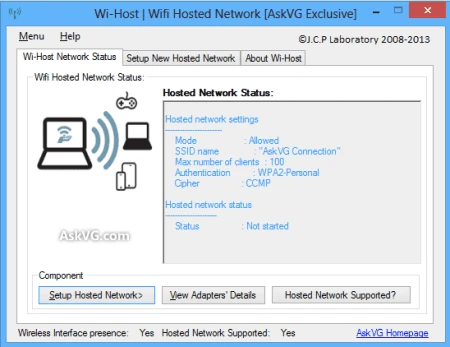A virtual router is a software-based device that allows you to create a secure network connection between two or more devices. It acts as a computer-based router, allowing you to share an internet connection and other resources among multiple computers or mobile devices. This can be especially useful for businesses that need to securely connect multiple sites together or for individuals who want to create a secure home network.
Virtual routers offer numerous benefits when compared to traditional hardware routers. For starters, they are much less expensive since they don’t require any additional hardware. Additionally, they are more reliable than hardware routers since they are not subject to physical damage and are also more flexible in terms of configuring them for different purposes.
Another great benefit of using virtual routers is that they can be easily moved between different platforms and upgraded without needing new hardware. This makes them much easier to maintain than traditional hardware routers and can save businesses money in the long run. Additionally, virtual routers have higher performance capabilities than their traditional counterparts, allowing them to take advantage of faster speeds and more features such as Quality of Service (QoS).
Finally, virtual routers offer better security than their traditional counterparts due to the fact that they can easily be configured with firewalls and other security measures. This makes them much better suited for connecting remote sites or even for setting up private networks at home or in the office.
Setting up a virtual router is actually quite simple but will depend on what type of device you are using (Windows PC, Mac, etc.). Generally speaking though, all you need to do is install the appropriate software on your machine, configure it with your desired settings, and then start sharing your connection with others!
For Windows PCs, there are several software options available including Connectify Hotspot and Virtual Router Manager which both allow you to quickly set up a secure wireless network with just a few clicks. On Macs, there’s also an app called AirPort Utility which allows you to do the same thing.
Once your virtual router has been set up successfully, all that’s left to do is connect your other devices (smartphones, laptops, etc.) so that they can access the internet through your shared connection!
virtual routers offer numerous benefits over traditional hardware solutions including cost savings, increased reliability and flexibility as well as better security capabilities thanks to support for firewalls and other security measures. They are also easy to set up on most modern operating systems so if you’re looking for an easy way to share an internet connection among multiple devices – then setting up a virtual router may be just what you need!

The Benefits of Using a Virtual Router
A virtual router is an essential tool for businesses looking to maximize their network efficiency and performance. Virtual routers provide a number of advantages over traditional hardware routers, making them an attractive option for businesses of all sizes.
Virtual routers allow companies to sidestep the initial costs associated with buying and maintaining physical routers, as well as the cost of software and hardware upgrades. vRouters can also be easily moved between different generations of hardware, allowing businesses to stay up-to-date with the latest technology. Additionally, virtual routers have much higher performance levels than legacy hardware routers and can easily handle large amounts of data traffic.
Finally, virtual routers are far more versatile than traditional hardware routers due to their ability to support multiple networks and protocols simultaneously. This makes them ideal for small businesses looking to manage multiple networks without having to purchase additional hardware. In addition, virtual routing can be quickly configured and reconfigured as needed, allowing businesses to respond quickly and efficiently to changing network demands.
Is Virtual Router a Free Service?
Yes, Virtual Router is completely free to use and is open source. It is available for download from the official website, and users can install it on any PC running Windows 8, Windows 7, or Windows Server 2008 R2. With Virtual Router, users can easily share any internet connection such as Wifi, LAN, Cable Modem, Dial-up, Cellular, etc. without any cost.
Advantages of a Virtual Router Over a Physical Router
A virtual router has several advantages over a physical router. Firstly, it can support multiple networks on a single router interface, by using different routing tables for each network. This allows for greater flexibility and scalability as more networks can be added without having to invest in additional hardware. Secondly, virtual routers are much easier to configure and maintain than physical routers, as they can be managed remotely from any computer connected to the same network. Finally, virtual routers are usually much more cost-effective than physical routers due to the lower cost of hardware and installation costs.
Example of a Virtual Router
A virtual router is a software-based network device that provides the same functionality as a physical router without the need for dedicated hardware. It can be used to connect two or more networks, such as LANs, WANs, and even the Internet. Examples of virtual routers include Juniper Networks’ vMX vRouter and Cisco’s Cloud Services Router 1000V series. The Juniper vMX vRouter is a powerful virtual router designed for Local and Wide Area Networking (WAN) applications, while the Cisco Cloud Services Router 1000V series offers advanced features and flexibility for both LANs and WANs. Both routers can be easily deployed in cloud environments, allowing businesses to take advantage of the scalability and cost savings associated with virtualization technology.
Is Virtualizing a Router Safe?
The safety of virtualizing a router depends on the security measures you take to protect your network. While virtual routers offer many advantages, such as cost savings and scalability, they can also leave your network open to attack if not properly configured and monitored.
It is important to ensure that your virtual router is properly secured by following best practices such as using secure passwords and restricting access to authorized personnel only. Additionally, strong firewalls should be implemented to protect against malicious traffic and potential vulnerabilities in the operating system of the virtual router. Regular patching and updating should also be done to ensure that any newly discovered vulnerabilities are quickly addressed. Lastly, it is important to monitor the router for any suspicious activity or attempts at unauthorized access.
Overall, while it is possible to safely virtualize a router with proper security measures in place, it is important to be aware of the potential risks associated with this approach. If you are unsure about how best to secure your virtualized router, consult with a security specialist who can provide guidance on how best to protect your network from threats.
Running a Virtual Router
1. Download and install a virtual router software program of your choice, such as Connectify Hotspot, Virtual Router Plus, or MyPublicWiFi.
2. Open the program and provide a name for your virtual router (i.e. “MyVirtualRouter”).
3. Set up a strong password for your virtual router to protect it from unauthorized access.
4. Select the type of network you would like to create (i.e. Wi-Fi, Ethernet Bridge).
5. Adjust any necessary settings such as IP address, DNS server, DHCP range, etc., depending on what your requirements are for the network you are creating.
6. Click “Start Virtual Router” or “Enable” to begin running the virtual router and start sharing your internet connection with other devices connected to it!
Setting Up a Virtual Server Router
To set up a virtual server router, you will need to access your router’s web interface. You can typically do this by typing the IP address of your router into a web browser. Once logged in, look for a section labeled “Advanced” or “NAT Forwarding”.
From there, select the option for “Virtual Servers” and then click “Add”. This will allow you to add a new virtual server configuration. To select the service you want to forward, click on “View Existing Services” and then choose the service you want to forward (e.g., HTTP). The external port, internal port, and protocol will be automatically filled in. Then enter the IP address of the PC or device that you want to forward traffic to (e.g., 192.168.). Finally, click “Apply” or “Save” to apply the changes and complete setting up your virtual server router configuration.
The Benefits of Using a Virtual Wi-Fi Router
A virtual Wi-Fi router is a software-based system that enables you to create and broadcast a wireless internet connection from your computer or laptop. It functions just like a traditional hardware router, allowing any other Wi-Fi-enabled device in the vicinity to connect to it and access the internet. Unlike a physical router, a virtual Wi-Fi router can be installed on any type of operating system without additional components or hardware. Additionally, its flexibility makes it easy to configure settings and customize the network for different types of devices. With a virtual Wi-Fi router, you can keep all your internet-enabled devices connected anywhere, anytime.
Conclusion
In conclusion, virtual routers are an incredibly useful and cost-effective tool for businesses and individuals alike. They allow users to easily share internet connections, sidestep hardware upgrade costs, and even work around legacy hardware performance limits. Furthermore, they are easily installed on PCs running Windows 8, 7, or Server 2008 R2 using the free open-source software Virtual Router. Additionally, Android users can utilize the tethering & portable hotspot settings to quickly set up their own virtual router in order to share their connection with others. As such, virtual routers offer a versatile and powerful solution for those looking to maximize their internet usage without spending a lot of money.








